Brain Implants
 In a Kurzweillian future, the world would become a very
strange place, where converging advances in nanotechnology, biotechnology
and computer science combine to propel humanity to its next stage of
evolution. "By the end of this century, I don't think there will be a
clear distinction between human and machine," Kurzweil told the Foresight Institute's
Eighth Conference on Molecular Nanotechnology.1
In a Kurzweillian future, the world would become a very
strange place, where converging advances in nanotechnology, biotechnology
and computer science combine to propel humanity to its next stage of
evolution. "By the end of this century, I don't think there will be a
clear distinction between human and machine," Kurzweil told the Foresight Institute's
Eighth Conference on Molecular Nanotechnology.1
The miracle of giving light to the blind i, ii or sound to the deaf has been made possible by implantation of electrodes, demonstrating the technical possibility of circumventing damaged sensory receptors by direct electrical stimulation of the nervous system.2 Computers that become part of our bodies are not so far-fetched.… Surgeons have performed [more than 40,000 3] cochlear implants on patients with hearing loss. "These people are already walking around with chips in their heads," [Peter Cochrane, head of research at British Telecommunications PLC,] says.4
Giving completely paralyzed patients full mental control of robotic limbs or communication devices has long been a dream of those working to free such individuals from their locked-in state.5
Scientists say they have developed a technology that enables a monkey to move a cursor on a computer screen simply by thinking about it.… Using high-tech brain scans, the researchers determined that [a] small clump[] of cells…were active in the formation of the desire to carry out specific body movements. Armed with this knowledge, [researchers at the California Institute of Technology in Pasadena] implanted sensitive electrodes in the posterior parietal cortex of a rhesus monkey trained to play a simple video game.… A computer program, hooked up to the implanted electrodes,…then moved a cursor on the computer screen in accordance with the monkey's desires - left or right, up or down, wherever "the electrical (brain) patterns tells us the monkey is planning to reach," according to [researcher Daniella] Meeker.6 [Dr. William Heetderks, director of the neural prosthesis program at the National Institute of Neurological Disorders and Stroke,] believes that the path to long-lasting implants in people would involve the recording of data from many electrodes. "To get a rich signal that allows you to move a limb in three-dimensional space or move a cursor around on a screen will require the ability to record from at least 30 neurons," he said.7
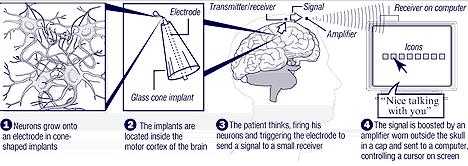 Dr. Philip R. Kennedy, an [sic] clinical assistant
professor of neurology at Emory University in Georgia, reported that a
paralyzed man was able to control a cursor with a cone-shaped, glass
implant.8 Each [neurotrophic electrode] consists of a hollow glass cone
about the size of a ball-point pen tip.9 The implants…contain an electrode that picks up
impulses from the nerve endings. Before they are implanted, the cones are
coated with chemicals - taken from tissue inside the patients' own knees -
to encourage nerve growth. The implants are then placed in the brain's
motor cortex - which controls body movement - and over the course of the
next few months the chemicals encourage nerve cells to grow and attach to
the electrodes. A transmitter just inside the skull picks up signals from
the cones and translates these into cursor commands on the
computer.10
Dr. Philip R. Kennedy, an [sic] clinical assistant
professor of neurology at Emory University in Georgia, reported that a
paralyzed man was able to control a cursor with a cone-shaped, glass
implant.8 Each [neurotrophic electrode] consists of a hollow glass cone
about the size of a ball-point pen tip.9 The implants…contain an electrode that picks up
impulses from the nerve endings. Before they are implanted, the cones are
coated with chemicals - taken from tissue inside the patients' own knees -
to encourage nerve growth. The implants are then placed in the brain's
motor cortex - which controls body movement - and over the course of the
next few months the chemicals encourage nerve cells to grow and attach to
the electrodes. A transmitter just inside the skull picks up signals from
the cones and translates these into cursor commands on the
computer.10
 |
 |
[Miguel Nicolelis and colleagues] at Duke University in North Carolina wired monkey brains to control robotic arms that mimicked the motions of their real arms.13 "It was an amazing sight to see the robot in my lab move, knowing that it was being driven by signals from a monkey brain at Duke," said [Massachusetts Institute of Technology's] Touch Lab director and co-researcher Mandayam Srinivasan. "It was as if the monkey had a 600-mile- (950-km-) long virtual arm."14
Scientists at Northwestern University crafted a two-wheeled robot that operated partly on the electrical signals of a displaced lamprey's brain (pic).15 The part of the brain used in the experiment normally keeps the lamprey upright in the water. When connected up correctly, the organ can guide the robot towards a light source.16
 Scientists at the
University of Tokyo are exploring ways that la cucaracha can become more
socially redeeming. Using hardy American roaches, scientists remove their
wings, insert electrodes in their antennae (more
pics) and affix a tiny backpack of electric circuits and batteries to
their carapace. The electrodes prod them to turn left and right, go
backward and forward. The plan is to equip them with minicameras or other
sensory devices.17, iii
Scientists at the
University of Tokyo are exploring ways that la cucaracha can become more
socially redeeming. Using hardy American roaches, scientists remove their
wings, insert electrodes in their antennae (more
pics) and affix a tiny backpack of electric circuits and batteries to
their carapace. The electrodes prod them to turn left and right, go
backward and forward. The plan is to equip them with minicameras or other
sensory devices.17, iii
 Rats steered by a computer…could soon
help find buried earthquake victims or dispose of bombs, scientists said
[1 May 2002]. The remote-controlled "roborats" (more pics)
can be made to run, climb, jump or turn left and right through electrical
probes, the width of a hair, implanted in their brains. Movement signals
are transmitted from a computer to the rat's brain via a radio receiver
strapped to its back. One electrode stimulates the "feelgood" center of
the rat's brain, while two other electrodes activate the cerebral regions
which process signals from its left and right whiskers.18 "They work for pleasure," says Sanjiv Talwar, the bioengineer at the State University
of New York who led the research team.… "The rat feels
nirvana." 19 Asked to speculate on potential military uses for
robotic animals, Dr Talwar agreed they could, in theory, be put to some
unpleasant uses, such as assassination.20
Rats steered by a computer…could soon
help find buried earthquake victims or dispose of bombs, scientists said
[1 May 2002]. The remote-controlled "roborats" (more pics)
can be made to run, climb, jump or turn left and right through electrical
probes, the width of a hair, implanted in their brains. Movement signals
are transmitted from a computer to the rat's brain via a radio receiver
strapped to its back. One electrode stimulates the "feelgood" center of
the rat's brain, while two other electrodes activate the cerebral regions
which process signals from its left and right whiskers.18 "They work for pleasure," says Sanjiv Talwar, the bioengineer at the State University
of New York who led the research team.… "The rat feels
nirvana." 19 Asked to speculate on potential military uses for
robotic animals, Dr Talwar agreed they could, in theory, be put to some
unpleasant uses, such as assassination.20
In 1870, two German researchers named [Eduard] Hitzig and [Gustav] Fritsch electrically stimulated the brains of dogs, demonstrating that certain portions of the brain were the centers of motor function. The American Dr. Robert Bartholow, within four years, demonstrated that the same was true of human beings. By the turn of the [twentieth] century in Germany Fedor Krause was able to do a systematic electrical mapping of the human brain, using conscious patients undergoing brain surgery [Morgan, James P., "The First Reported Case of Electrical Stimulation of the Human Brain," Journal of History of Medicine at http://www3.oup.co.uk/jalsci/scope/; Zimmerman, M., "Electrical Stimulation of the Human Brain," Human Neurobiology, 1982].
Another early researcher into electrical stimulation of the brain was Walter Rudolf Hess, who began research into ESB in the 1930s, jolting patients' brains with shocks administered through tiny needles that pierced the skull.21 His experiments [also] included the insertion of fine electrically conductive wires into the brains of anaesthetized cats. To noone's great surprise, given mild electrical stimulation the cats went beserk [Vance Packard, The People Shapers (New York: Bantam Books, 1977); "Hess, Walter Rudolf," Encyclopedia Americana (New York: Harper & Row, 1969); "Hess, Walter Rudolph," Funk & Wagnalls New Encyclopedia (New York: Funk & Wagnalls Inc., 1973)].22
 During the decades of the 1940s and 1950s, Wilder Penfield…experimented with electrical brain
stimulation on patients undergoing surgery. One of Penfield's discoveries
was that the application of electricity on alert patients could stimulate
the memory of past events (full
pic) [Project Open Mind].
During the decades of the 1940s and 1950s, Wilder Penfield…experimented with electrical brain
stimulation on patients undergoing surgery. One of Penfield's discoveries
was that the application of electricity on alert patients could stimulate
the memory of past events (full
pic) [Project Open Mind].
Since 1949, the Tulane University Department of Psychiatry and Neurology has done experimentation in the implantation of electrodes into patients' brains. According to one of their staff-generated reports, "By implantation of electrodes into various predetermined specific brain sites of patients capable of reporting thoughts and feelings, we have been able to make invaluable long-term observations…" ["Stereotaxic Implantation of Electrodes in the Human Brain: A Method for Long-Term Study and Treatment," Heath, John, Fontana, Department of Psychiatry and Neurology, Tulane University School of Medicine].
Other early researchers into direct brain stimulation were Robert G. Heath…and his associate, Dr. Russell Monroe. Beginning in 1950, with funding from the CIA and the military, among other sources, they implanted as many as 125 electrodes into subjects' brains, and also experimented by injecting a wide variety of drugs directly into the brain tissue through small tubes; these drugs included LSD, psilocybin, and mescaline. One of Heath's memorable suggestions was that lobotomy should be used on subjects, not as a therapeutic measure, but for the convenience of the staff [Heath, Robert G. Undated interview in Omni; Cannon, Martin, "Mind Control and the American Government," Prevailing Winds, 1994; Human Rights Law Journal, "Freedom of the Mind as an International Human Rights Issue," Vol. 3, No. 1-4; Ross, M.D., Dr. Colin, "The CIA and Military Mind Control Research: Building the Manchurian Candidate," lecture given at Ninth Annual Western Clinical Conference on Trauma and Dissociation, April 18, 1996].23 Heath of Tulane University, who pioneered the electrical stimulation of human brains, has equipped dangerously aggressive mental patients with self-stimulators. A film shows a patient working himself out of a violent mood by pushing his stimulator button.24
In 1956, James Olds (pic) reported on research in which he had electrically stimulated the brains of rats. Implanting electrodes in rats' pleasure center of the brain, he attached a device that allowed the rats to activate the electrical impulse. He found that the rats would become so obsessed with self-stimulation that they would literally starve themselves to death.25
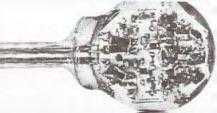 Jose Delgado, funded by Yale University, the Office of
Naval Intelligence, the U.S. Air Force 6571st Aeromedical Research
Laboratory, and other institutions, and linked to Spanish fascist groups
by researcher John Judge,26…is the man who perfected the stimoceiver, a tiny
electronic device that is implanted into the brains of humans and animals,
and is used to transmit electrical impulses directly to the brain [Delgado, Jose, Physical Control of the Mind (New York: Harper
& Row, 1969); and Judge, John, "The Secret Government," Dharma
Combat number 10].27
Jose Delgado, funded by Yale University, the Office of
Naval Intelligence, the U.S. Air Force 6571st Aeromedical Research
Laboratory, and other institutions, and linked to Spanish fascist groups
by researcher John Judge,26…is the man who perfected the stimoceiver, a tiny
electronic device that is implanted into the brains of humans and animals,
and is used to transmit electrical impulses directly to the brain [Delgado, Jose, Physical Control of the Mind (New York: Harper
& Row, 1969); and Judge, John, "The Secret Government," Dharma
Combat number 10].27
 Delgado, in a series of experiments terrifying in their human potential,
implanted electrodes in the skull of a bull. Waving a red cape, Delgado
provoked the animal to charge. Then, with a signal emitted from a tiny
hand-held radio transmitter, he made the beast turn aside in mid-lunge and
trot docilely away.28 He has [also] been able to "play" monkeys and cats
like "little electronic toys" that yawn, hide, fight, play, mate and go to
sleepiv on command.29 The individual is defenseless against direct
manipulation of the brain [Delgado, Physical
Control].30
Delgado, in a series of experiments terrifying in their human potential,
implanted electrodes in the skull of a bull. Waving a red cape, Delgado
provoked the animal to charge. Then, with a signal emitted from a tiny
hand-held radio transmitter, he made the beast turn aside in mid-lunge and
trot docilely away.28 He has [also] been able to "play" monkeys and cats
like "little electronic toys" that yawn, hide, fight, play, mate and go to
sleepiv on command.29 The individual is defenseless against direct
manipulation of the brain [Delgado, Physical
Control].30
The open publication of Delgado's book Physical Control of the Mind met with a decidedly cool reaction from the public, and this may have warned other researchers in the field to keep quiet about the subject. To this day, Delgado's is the only popular book on the subject of implants and electrical stimulation of the brain.31
During the latter days of MKULTRA research, a CIA memorandum, dated 22 November, 1961, announced, "Initial biological work on techniques and brain locations essential to providing conditioning and control of animals has been completed. The feasibility of remote control of activities in several species of animals has been demonstrated.… The ultimate objective of this research is to provide an understanding of the mechanisms involved in the directional control of animals and to provide practical systems suitable for human application." 32
Later breakthroughs in technology were documented in "Two-Way Transdermal Communication with the Brain," published in 1975. By this time Delgado had linked his brain implants with computers. The monograph records,
"The most interesting aspect of the transdermal stimoceivers is the ability to perform simultaneous recording and stimulation of brain functions, thereby permitting the establishment of feedbacks and 'on-demand' programs of excitation with the aid of the computer. With the increasing sophistication and miniaturization of electronics, it may be possible to compress the necessary circuitry for a small computer into a chip that is implantable subcutaneously. In this way, a new self-contained instrument could be devised, capable of receiving, analyzing, and sending back information to the brain, establishing artificial links between unrelated cerebral areas, functional feedbacks, and programs of stimulation contingent on the appearance of pre-determined patterns" [Delgado, Lipponen, Weiss, del Pozo, Monteagudo, and McMahon, "Two-Way Transdermal Communication with the Brain," a co-operative publication of the Medical University of Madrid, Spain, and Yale University Medical School, 1975].33
Many popular articles on Delgado intend us to think that his primary purpose was the rehabilitation of the mentally and physically sick. This does not happen to be the case. Delgado was a blatant control freak. An example is Delgado's experimentation on changing the social orientation of animals. One staging area for this experimentation was an island in the Bermudas, where Delgado maintained a free-roving population of gibbons with electronic implants, using electrical brain boosts to build and destroy social orders among those primates as if he was knocking down a row of dominoes [Packard, People Shapers].34
Always a visionary in the Orwellian mold, Delgado said, "Looking into the future, it may be predicted that telerecording and telestimulation of the brain will be widely used" [Delgado, Jose, "Radio Stimulation of the Brain in Primates and Man," New Haven, Connecticut: Department of Psychiatry, Yale University School of Medicine, 1969].35 He has urged the U.S. government to make "control of the mind" a national goal.36
Another researcher who specialized in brain implants is Dr. Stuart Mackay, who in 1968 penned a textbook titled Bio-Medical Telemetry. Mackay reported, "Among the many telemetry instruments being used today are miniature radio transmitters that can be swallowed, carried externally, or surgically implanted in man or animal. They permit the simultaneous study of behaviour and physiological functioning. The scope of observations is too broad to more than hint at a few examples. The possibilities are limited only by the imagination of the investigator" [Dr. Stuart Mackay, cited in Glenn Krawcyzyk, "Mind Control Techniques and Tactics of the New World Order," Nexus, Dec-Jan 1993].37
By 1994, the London Times estimated that in the previous decade there had been 15,000 cases of persons being implanted with electronic brain devices. It is impossible to know if the Times estimate is at all accurate, since it is unlikely that they would be privy to statistics of secret testing. Certainly, most anti-mind control activists would say that the figure was a gross underestimate.38
In July 1996, information was released on research currently taking place into creation of a computer chip called the "Soul Catcher 2025." Dr. Chris Winter and a team of scientists at British Telecom's Martlesham Heath Laboratories, near Ipswich, are developing a chip that, when placed into the skull behind the eye, will record all visual and physical sensations, as well as thoughts. According to Winter, "This is the end of death… By combining this information with a record of the person's genes, we could recreate a person physically, emotionally, and spiritually." 39
"The brain is so complex that one wouldn't at the outset think that replacing any of its parts is doable," said Dr. Howard Eichenbaum, a professor of psychology at Boston University and director of the Laboratory of Cognitive Neurobiology there. But advances in neuroscience and computer engineering have made it possible to develop implanted circuits that mimic neural activities, he said. "At least in principle, it looks as though a chip imitating some functions of the hippocampus could be implanted in the future," he said. "It's a huge, huge advance in simply duplicating the functions of the hippocampus, which in many ways Dr. [Theodore W.] Berger, [a professor of biomedical engineering at the University of Southern California in Los Angeles and the director of the Center for Neural Engineering there,] has done." 40
Electrical devices called deep brain stimulators, essentially a pacemaker for the brain, have been used for some years to ease the symptoms of Parkinson's disease. Now, they've just been approved for another degenerative brain disease called dystonia.… The brain stimulators don't cure dystonia but…they can give patients a better quality of life. The beneficial effect has lasted for almost a decade so far in Parkinson's patients, and it's expected the dystonia effect will also be long lasting.41
i A handful of researchers are plumbing the potential
of the bionic eye, including Wheaton, Ill.-based Optobionics Corp.,
led by Dr. Alan Chow, a pediatric ophthalmologist whose artificial silicon
retinas have slight improved the vision of the six patients who've
received them.
- Jim Krane (The Associated Press) "Bionic Eye Follows Bionic Ear,"
Yahoo!
News, 27 May 2002.
ii A small, precise dose of electricity can restore
sight to some of the million or so Americans considered legally blind. For
the past few months, two patients have made out doctors in white lab
coats, among other things, thanks to a complex apparatus…made by Second Sight, a privately
held firm in Santa Clarita, Calif. The device includes a tiny antenna
inside the eye and a retinal implant with pencil-tip-size electrodes that
fire electrical signals directly onto the optic nerves and brain. The
resolution is extremely crude because there are only 16 electrodes, not
enough to recognize faces. Second Sight and a consortium of research
laboratories recently received a $9 million federal grant to find a way to
squeeze 1,000 electrodes onto the array to make the picture sharper.
Powered by an external battery, a mini video camera screwed into a pair of
eyeglasses will wirelessly beam images to the array (pic) - all for an estimated cost, including surgery, of
$25,000. Scientists concede facial recognition may be five to ten years
away. So far, Second Sight has reported no negative side effects in the
two patients undergoing clinical trials.
- Aliya Sternstein, "Seeing-Eye Chip," Forbes, 14 Oct 2002.
iii Be on guard next time you step into the shower. It
might not be a regular cockroach watching you on the ceiling. It could be
a well-heeled voyeur's spy filming you!
- Ron Henderson, trans.,
"Cockroaches on a secret mission," Sydsvenska Dagbladet, 18
Jan 1997, at http://magazine.magnus.se/artikele.asp?artikel=kackerla.
iv Sleep induced by electrical stimulation of the
brain is similar to spontaneous sleep.
- José M. R. Delgado, M.D.,
Physical Control of the Mind: Toward a Psychocivilized
Society (New York: Harper & Row, 1969), p. 158.
Endnotes
1 Declan McCullagh, "Kurzweil: Rooting for the Machine," Wired News, 3 Nov 2000.
2 José M. R. Delgado, M.D., Physical Control of the Mind: Toward a Psychocivilized Society (New York: Harper & Row, 1969), p. 201.
3 Cochlear Hearing Implants, "New to Cochlear? Start Here," at http://www.cochlear.com/NewToCochlear/new_to_cochlear_index.asp.
4 Neil Gross, "Into the wild frontier," Business Week, 23 June 1997, p. 74.
5 E. J. Mundell (Reuters Health), "Monkey Moves Computer Cursor by Thoughts Alone," Yahoo! News, 30 Jan 2002.
6 Op cit.
7 Anne Eisenberg, "Don't Point, Just Think: The Brain Wave as Joystick," The New York Times, 28 March 2002.
8 Paul Eng, "Moving Thoughts: Scientists Study Brain Implants to Control PCs, Artificial Limbs," ABCNEWS.com, 13 March 2002.
9 "Communicating with 'thought power'," BBC, 15 Oct 1998.
10 Jane Wakefield, "BodyTechnic: New funding for brain implants," ZDNet UK News, 3 Dec 1998.
11 Amanda Onion, "Rat Robots: Scientists Develop Remote-Controlled Rats," ABCNEWS.com, 2 May 2002.
12 "Rats Operate Robotic Arm Via Brain Activity," Science Daily, 23 June 1999.
13 Eng, "Moving Thoughts."
14 "Monkey brain operates machine," BBC, 15 Nov 2000.
15 Onion, "Rat Robots."
16 "Fish-brained robot at Science Museum," BBC, 27 Nov 2000.
17 "Peepers creepers; Research at the University of Tokyo is investigating ways in which cockroaches with the mini-cameras can be used to locate vermin or perhaps even survivors of earthquakes," Time, 27 Jan 1997, 149(4), p. 17.
18 Reuters, "Remote-Controlled Rats May Hunt Bombs and Bodies," Yahoo! News, 2 May 2002.
19 Tom Clarke, "Here come the Ratbots; Desire drives remote-controlled rodents," Nature, 2 May 2002.
20 James Meek, "Live rats driven by remote control," The Guardian, 2 May 2002.
21 Jim Keith, Mass Control: Engineering Human Consciousness (Lilburn, GA: IllumiNet Press, 1999), p. 94.
22 Jim Keith, Mind Control, World Control (Kempton, IL: Adventures Unlimited Press, 1998), p. 127.
23 Keith, Mass Control, pp. 94-95.
24 Vance Packard, The People Shapers (Boston: Little, Brown & Co., 1977), p. 45.
25 "Brain, Mind, and Altered States of Consciousness," New Enlightenment.
26 Keith, Mind Control, p. 127.
27 Keith, Mass Control, p. 97.
28 Alvin Toffler, Future Shock (Toronto: Bantam Books, 1988, 1970), p. 194.
29 John A. Osmundsen, "'Matador' With a Radio Stops Wired Bull," The New York Times, 17 May 1965, CXIV(39,195), p. 20.
30 Jose Delgado, cited in Keith, Mind Control, p. 128.
31 Ibidem, pp. 129-130.
32 Ibidem, p. 130.
33 Keith, Mass Control, p. 99.
34 Ibidem, p. 100.
35 Ibidem, p. 101.
36 Packard, People Shapers, p. 4.
37 Keith, Mass Control, p. 101.
38 Keith, Mind Control, p. 138.
39 Ibidem, p. 302.
40 Anne Eisenberg, "What's Next; A Chip That Mimics Neurons, Firing Up the Memory," The New York Times, 20 June 2002; See also USC Engineering News at http://www.usc.edu/dept/engineering/bergerNYT.
41 "Brain 'Pacemaker' Helps Alleviate Symptoms Of Dystonia; Disease Makes Patients Stiffen Up So Much They Lose Mobility," wnbc.com, 21 July 2003.
See also
Cortical implantsNeuroprosthesis Research Organization
W. Ross Ashby's "An Introduction to Cybernetics"
Cochlear and ocular implant videos:
Lamprey cyborg video:
Rat cyborg audio:
Remote-controlled rat video:
ConditioningHypnotism
Cloning
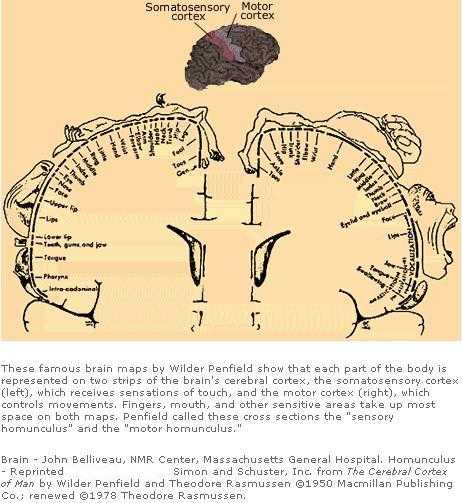
Lampry cyborg
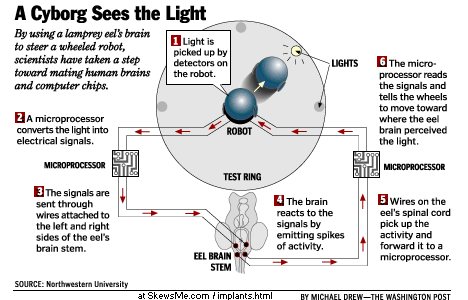
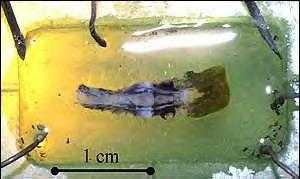
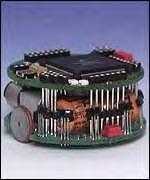
Remote-controlled cockroach

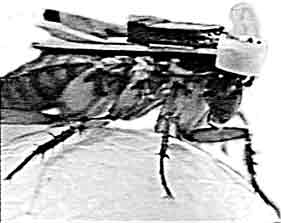
Remote-controlled rat


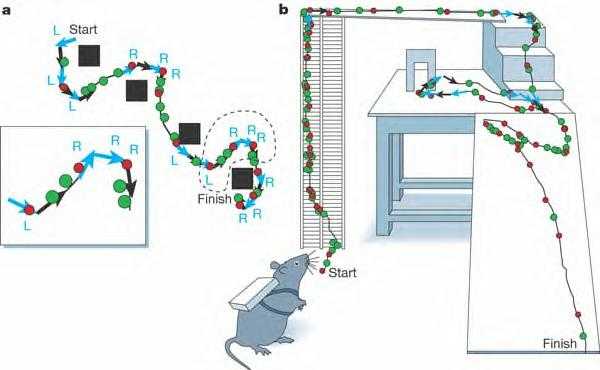
|
Examples of guided rat navigation using brain microstimulation. Sketches are constructed from digitized video recordings. Red dots indicate rat head positions at 1-s intervals; green dots indicate positions at which reward stimulations were administered to the medial forebrain bundle (MFB); blue arrows indicate positions at which right (R) and left (L) directional cues were issued; black arrows indicate positions 0.5 s after directional commands. a, Route followed by a rat guided through a slalom course. Inset, detail of the events that took place inside the dashed enclosure. b, Route taken by a rat guided over a three-dimensional obstacle course. The animal was instructed to climb a vertical ladder, cross a narrow ledge, descend a flight of steps, pass through a hoop and descend a steep (70º) ramp. Two rounds of high-density MFB stimulation were required to guide the rat successfully down the ramp, demonstrating the motivational qualities of MFB stimulation. - Sanjiv K. Talwar, Shaohua Xu, Emerson S. Hawley, Shennan A. Weiss, Karen A. Moxon & John K. Chapin, "Behavioural neuroscience: Rat navigation guided by remote control," Nature, 417, 37-38 (2002).
|